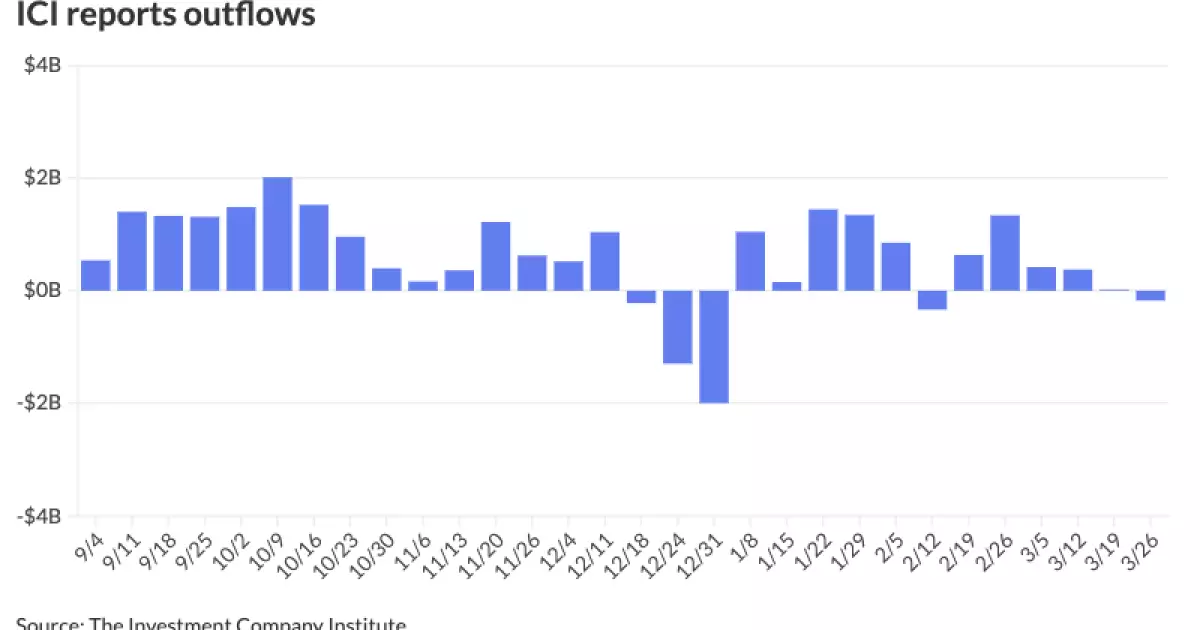The atmosphere surrounding U.S. financial markets is becoming increasingly fraught with uncertainty, particularly as we witness political decisions that directly impact economic conditions. In recent times, the turbulence seen in the stock market and U.S. Treasury yields can largely be attributed to President Trump’s bold move of announcing sweeping tariffs during a speech from the Rose Garden. The very act of implementing such tariffs not only raises the stakes in trade negotiations, but also sends shockwaves of apprehension throughout the market.
As financial analysts and investors sift through the fog of uncertainty, one fact stands out: confidence in the market is deteriorating. Critics argue that the unstable political landscape and insufficient clarity on what these tariffs entail are playing a significant role in diminishing business sentiment. The markets are caught in a storm of fear rather than rational evaluation of the fundamentals, leading to erratic behaviors among various asset classes, notably equities and bonds. This unnerving sentiment hints strongly at an impending crisis—where speculation and hype outweigh sustainable economic indicators.
Unpacking the Tariff Complexities
The details surrounding these newly announced tariffs remain murky, leaving room for speculation and anxiety among investors. J.P. Morgan’s strategists have weighed in, suggesting that these tariffs could be used as leverage in trade deals, yet they also express profound uncertainty regarding both the specifics of the tariffs and their long-term implications. Are we poised for reciprocal tariffs, or will certain industries, like pharmaceuticals, see delayed implementations?
Such unpredictability can only weigh heavily on market behavior. Tariffs are intended to protect domestic industries but can also act as a constraint on economic growth if implemented without careful consideration. The current crisis is further exacerbated by geopolitical tensions that add layers of instability, making it crucial for policymakers to tread carefully.
Fear Over Fundamentals
A growing chorus of voices in the financial sector is warning that underlying economic fundamentals are not matching the current sentiment. James Pruskowski, chief investment officer at 16Rock Asset Management, succinctly states that “fear is driving markets,” overshadowing solid indications of global expansion. Companies are starting to brace for impact, marking a drastic shift in the tone of corporate leadership.
The substantive worries about potential recessions are echoed by alarming profit warnings from major corporations like FedEx and heightened signs of crumbling CEO confidence. The Federal Reserve’s unwavering focus on inflation, while ignoring the rising risks of stagflation, further complicates the landscape. The refusal to acknowledge these issues raises questions about the effectiveness of monetary policy in addressing the increasingly complicated economic landscape.
Effects on Municipal Securities
Municipal securities are not immune to this growing chaos. With tightening liquidity and murky fiscal prospects for essential sectors like healthcare and education, the market is witnessing significant outflows, signaling increased stress. As municipal bond fundamentals remain intact, there is an build-up of pressure due to an uncertain policy environment, amplifying underlying risks.
Discussion surrounding capping the muni bond tax exemption at 28%—a topic that has historically been met with resistance—has resurfaced. Market participants are preparing for potential challenges ahead. The futility of trying to regulate municipal bonds can lead to larger negative repercussions, creating a perfect storm where essential government functions are jeopardized in pursuit of federal budgetary goals.
Upcoming Assessments and Projected Impacts
Entering the primary market, several noteworthy bond offerings are on the horizon. Notable among them is the California Educational Facilities Authority’s issuance of $600 million in revenue bonds, pointing to ongoing investment in vital infrastructure. The willingness of entities like the J. Paul Getty Trust to price taxable corporate CUSIPs indicates a demand for funding amidst uncertain circumstances. Yet, the underlying stress should not be overlooked, as institutional investors weigh these new securities against a backdrop of volatile interest rates.
As investors, we must tread with care. In a climate where market sentiment roots itself in fear and the specter of recession looms, the challenges will not simply dissipate overnight. Careful monitoring of economic indicators, trade negotiations, and geopolitical developments will be paramount in navigating these tumultuous waters.
The Shifting Landscape of Investment Trust
In this environment of uncertainty, our faith in traditional investment avenues is being tested. The dynamics of fixed income markets and municipal securities are morphing under pressure, reshaping the landscape for investors and policymakers alike. Questions around risk, return, and liquidity are more pertinent than ever. The necessity for a balanced approach that addresses growth while still safeguarding public interests has never been more crucial.
Investors must adopt a more discerning eye, deeply analyzing projects and fiscal policies that underlie bond offerings. As political winds shift and market dynamics become more volatile, focusing on the fundamentals while remaining aware of external pressures may yield insights that can ultimately support better decision-making in this precarious financial climate.

